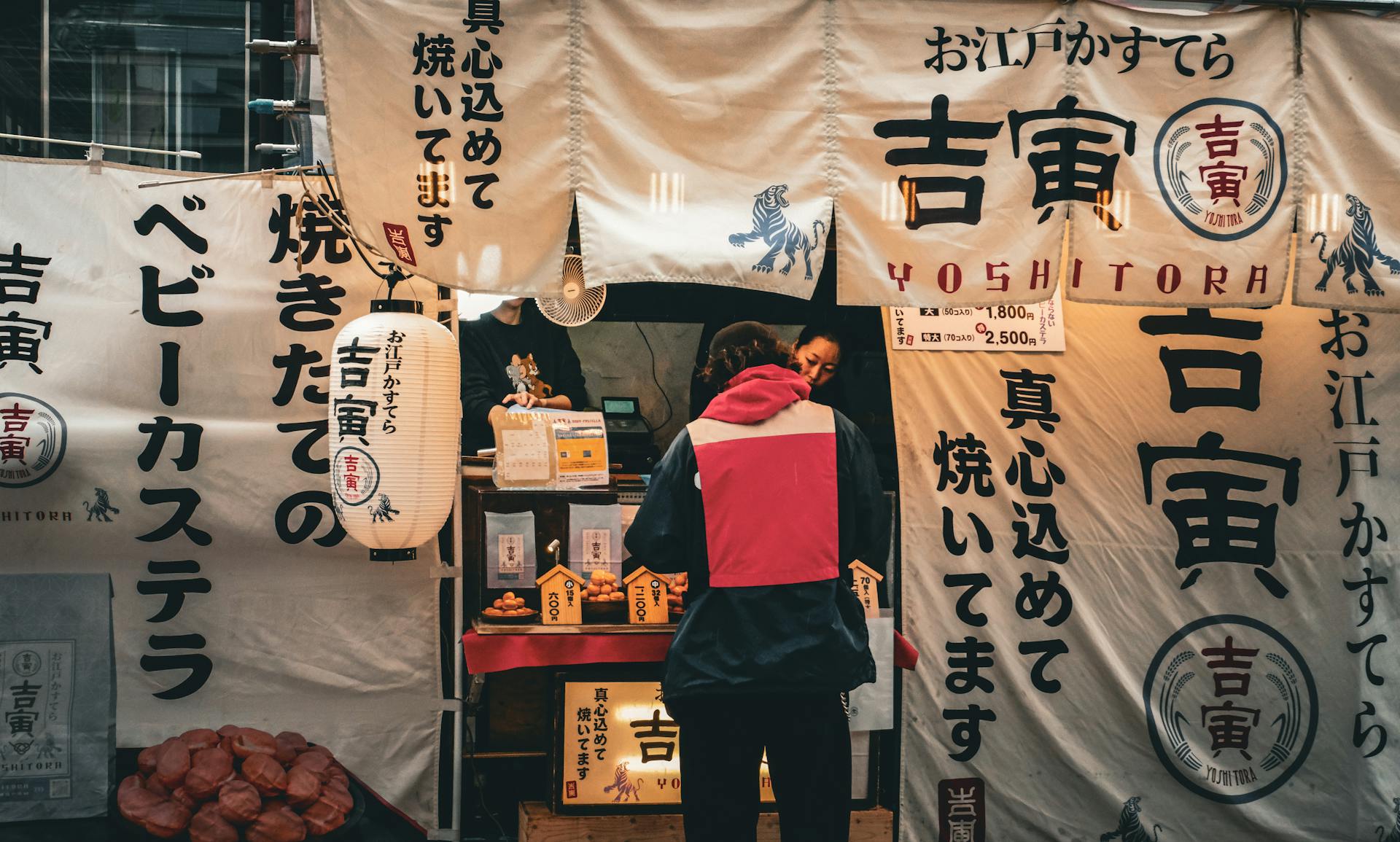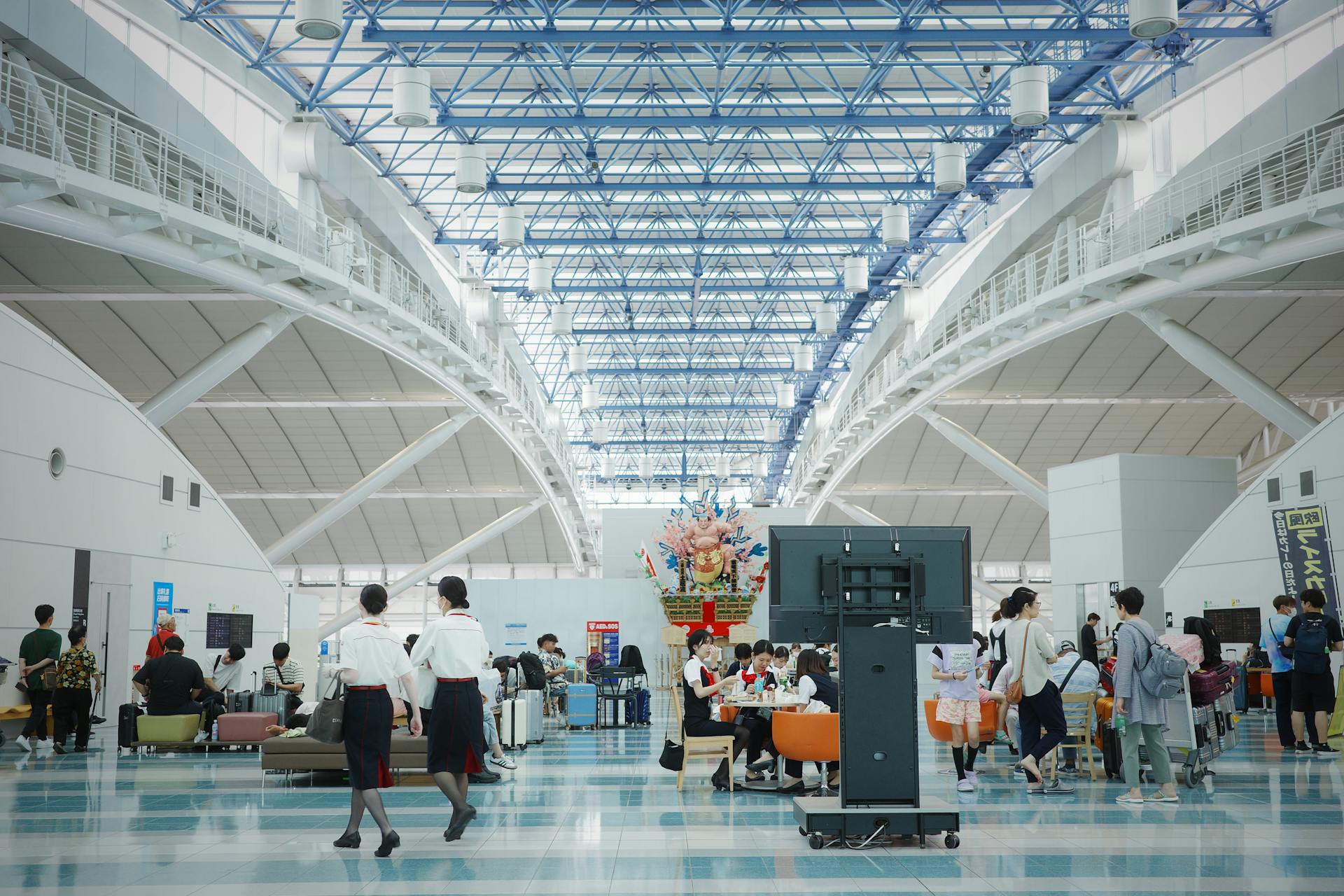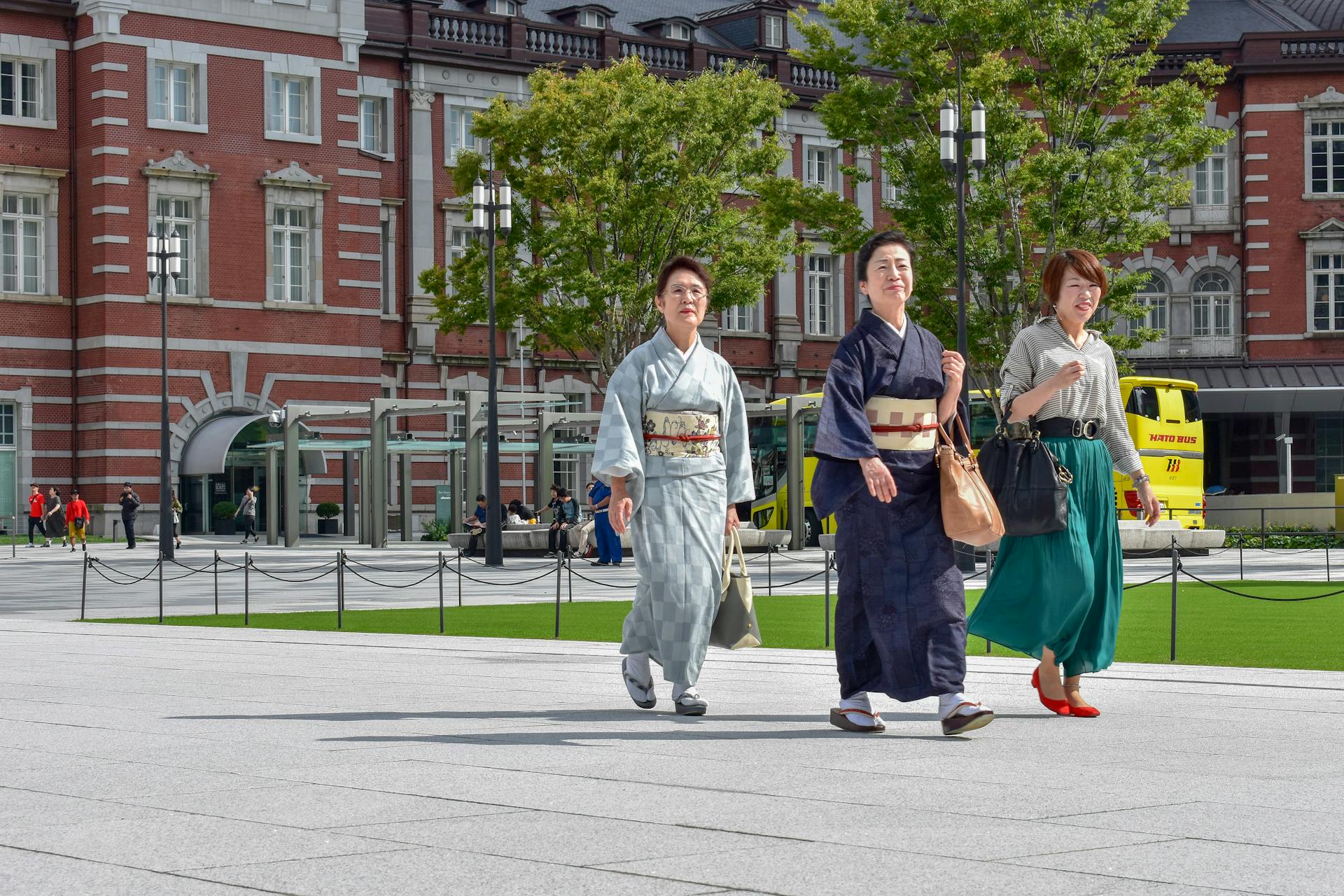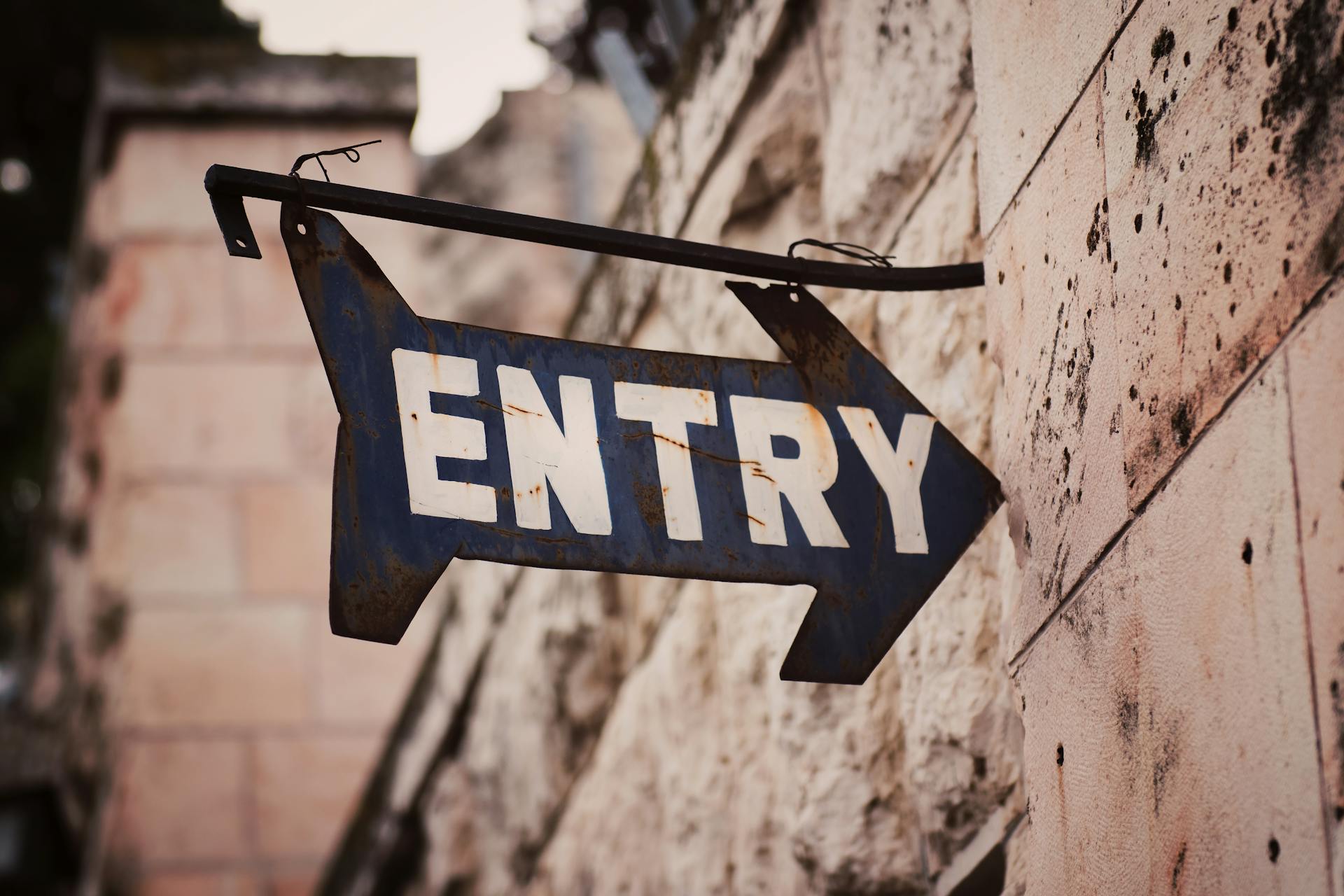
Japan Airport Security and Customs can be a daunting experience, but with some knowledge, you'll be navigating through it like a pro.
Security checks at Japanese airports are generally strict and thorough.
Before you arrive at the airport, it's a good idea to familiarize yourself with the security regulations, which can be found on the airport's website or through the airline's app.
In Japan, electronic devices are subject to additional screening, so be prepared to have your laptop and phone removed from your carry-on bag.
Japan Airport Security and Customs
As you arrive in Japan, you'll go through a series of procedures to ensure a smooth entry. The typical process is: quarantine screening, immigration, baggage claim, animal and plant inspection, customs, and arrival lobby.
You'll need to prepare a few things before arriving in Japan, including completing a customs declaration form and being aware of duty-free limits. The duty-free limits for Japan include up to 3 bottles of alcohol, 200 cigarettes or 50 cigars (or 10 packs of heated tobacco), and 2 ounces of perfume.
Check this out: Indian Customs Duty Free Allowance 2024
At customs, you'll be checked for prohibited or restricted items, large amounts of cash that require declaration, and whether personal belongings fall within duty-free limits. You can use the Visit Japan Web online system to speed up the process, or complete a paper customs declaration form if you're not using the online system.
If you're a Japanese national, you can use the ePassport gates, which are recommended. A stamp will not be provided, so if you require a stamp, you'll need to ask an attendant after passing through the gate. Foreign nationals will also need an arrival card, which you'll need to present at immigration control.
At immigration control, you'll see three lines: Japanese Passport Holders, Foreign minors under 18 traveling alone, and Foreign adults over 18. Make sure you've completed your information on the Japan Visit Web before your arrival, and be prepared to present a QR code generated by this site.
Here's a summary of what you'll need to do at immigration control:
- Present your QR code and passport.
- The immigration officer will take your fingerprint scans and a photo of your face.
- You'll receive a sticker in your passport with the date of entry, allowing you to stay in the country for up to 90 days.
Remember to also be aware of restrictions on exports and imports, including the prohibition on international trade in ivory under CITES and Japanese Law.
Electronic Declaration

Passengers can complete their customs declaration at the electronic declaration terminal, where they must hold their IC passport and 2D code over the terminal scanner.
To complete the declaration, passengers must follow the terminal's guidance and have their face photos taken to verify their identification with the photo inside their IC passport.
Face photos taken at the terminal are used only for identification and facial recognition at the gate, and are deleted immediately after passengers pass through.
Passengers may be asked to go to the e-Gate or customs inspection desk depending on their declaration.
Even when passengers declare electronically, their baggage may still be inspected by Customs officers.
Face photos are taken again at the electronic declaration gate for the purposes of facial recognition, and are deleted immediately after passengers pass through.
Check this out: Electronic Security Tags
Entry Procedures
As you arrive in Japan, you'll go through a series of procedures to ensure a smooth entry. You'll start with quarantine screening, which may seem like a straightforward process, but it's essential to be prepared.
The typical process is: quarantine screening → immigration → baggage claim → animal and plant inspection → customs → arrival lobby. The order may vary slightly depending on the airport, but this is the general sequence.
Once you've cleared quarantine, you'll proceed to immigration control, where you'll need to present your passport and complete the entry procedure. This will depend on your status as a Japanese national, re-entering Japan, or a foreign national.
Immigration control is a crucial step in your arrival in Japan, and you'll see three lines: Japanese Passport Holders, Foreign minors under 18 traveling alone, and Foreign adults over 18.
To speed up the process, make sure you've completed your information on the Japan Visit Web before your arrival. You'll need to present a QR code generated by this site at immigration control, so have it ready.
Here's a brief overview of what to expect at immigration control:
- Present your QR code and passport.
- The immigration officer will take your fingerprint scans and a photo of your face.
- You'll receive a sticker in your passport with the date of entry, allowing you to stay in the country for up to 90 days.
Don't forget that you'll also need to hand in a Customs Declaration form for both your personal effects and unaccompanied baggage at the Customs Clearance. These forms are available on the plane, ship, or at the airport Customs Inspection Area, or you can use e-filing via web page or QR code.
Restrictions are placed on duty-free allowances, so make sure you're aware of the limits. Similar restrictions also apply to exports and imports, including international trade in ivory, which is prohibited by CITES and Japanese Law.
Quarantine and Inspection

Quarantine checks are conducted to prevent the spread of infectious diseases and apply to all travelers entering or returning to Japan, regardless of nationality. You can answer health questions online before arrival using Visit Japan Web, or fill out a paper questionnaire on the plane.
If you're using Visit Japan Web, scan your QR code and passport at an electronic customs terminal after arriving in Japan. If your items are within duty-free limits and no declaration is needed, proceed through the e-gate.
Here are the duty-free limits for travelers entering Japan:
If you're bringing any meat, fruits, animals, or plants into Japan, you'll need to undergo an import procedure after claiming your baggage. This is required depending on your country or region of departure.
Quarantine Screening
Quarantine Screening is a crucial step in preventing the spread of infectious diseases when entering or returning to Japan. All travelers, regardless of nationality, must undergo quarantine checks.
You can answer health questions online before arrival using Visit Japan Web, which makes the process smoother. However, if you're not using the service, a health questionnaire will be handed out on the plane.
The questionnaire is straightforward and requires you to disclose your current condition. This information is essential in determining the necessary precautions to take.
Depending on your country of departure, you may need to undergo additional checks for importing certain items, such as meat, fruits, animals, or plants. These items require special handling and inspection after claiming your baggage.
Here's a quick rundown of the items that may require import procedure:
- Meat
- Fruits
- Animals
- Plants
You can find more information about animal and plant quarantine procedures by visiting the respective sections on the official website.
Step 3 Inspection
You're about to exit Japan, and the next step is customs inspection. Customs procedures are required when departing Japan, so be prepared to complete the designated customs form if you're carrying foreign-made goods or have cash worth over one million yen.

If you've made tax-free purchases, you'll need to present both your passport and the purchased items at customs. It's a good idea to do this before handing over your suitcase to the airline, especially if you're placing the items in checked luggage.
You'll need to complete the customs check before checking in your luggage, so make sure to do it in time.
If you're carrying prohibited items like meat or dairy products, be aware that they're strictly banned from being imported into Japan. Don't risk getting caught with these items, or you might face some trouble.
Here's a quick rundown of the transportation options available from the airport:
Alternatively, you can take the Narita Express (N'EX) or JR Sôbu Line. The Narita Express is the fastest and most comfortable option, taking 1 hour to reach your destination for a round-trip fare of 5,000 yen. The JR Sôbu Line is a slower but cheaper option, taking 1 hour 40 minutes for a fare of 1,340 yen.
Curious to learn more? Check out: Inland Customs Line
Step 5: Customs Inspection

As you arrive in Japan, you'll need to go through customs inspection. This is where you'll be checked for prohibited or restricted items, such as large amounts of cash that require declaration, and whether your personal belongings fall within duty-free limits.
To speed up the process, you can use the Visit Japan Web online system, which allows you to scan your QR code and passport at an electronic customs terminal. If your items are within duty-free limits and no declaration is needed, you can proceed through the e-gate.
Duty-free limits in Japan include up to 3 bottles of alcohol, 200 cigarettes or 50 cigars (or 10 packs of heated tobacco), and 2 ounces of perfume. If you're carrying goods that exceed these limits or need to declare items, you'll need to go to a staffed inspection desk.
If you're not using the online system, you'll need to complete a paper customs declaration form and present it at a staffed counter. Make sure to familiarize yourself with the customs procedures and duty-free limits to avoid any issues during inspection.
On a similar theme: Us Customs Inspection Station Cettificate Study Guide

Here's a summary of the duty-free limits in Japan:
Remember to also be aware of restrictions on exports and imports, including CITES (Convention on International Trade in Endangered Species of Wild Fauna and Flora) and Japanese Law, which prohibit international trade in ivory.
Baggage and Customs
Collecting your bags at the baggage claim area is a straightforward process. You'll find the baggage claim area after arriving at your destination, and it's where you'll collect your checked luggage.
Please check one of the nearby flight information boards to confirm the correct belt number for baggage collection according to your airline and flight number. You can then collect your luggage from the corresponding belt.
After collecting your bags, you'll go through customs, which is a quick and automated process that takes around 10 minutes. You'll use the QR code generated on the Japan Visit Web to scan your code and passport at an automated kiosk, which will verify the customs information you submitted earlier and print an exit ticket.
Related reading: Union Customs Code

Make sure you're not carrying any prohibited items, such as meat or dairy products, as they are strictly banned from being imported into Japan.
Here are some options for traveling to your destination from the airport:
- Skyliner: The fastest option / 45 minutes for 2,470 yen.
- Keisei Access Express: A good balance / 1 hour for 1,240 yen.
- Keisei Main Line: The most affordable / 1 hour 30 minutes for 1,030 yen.
Alternatively, you can take the Narita Express (N'EX) for a faster and more comfortable journey, or the JR Sôbu Line for a slower but cheaper option.
Baggage Claim
At the baggage claim, you'll need to collect your check-in luggage at the designated area.
Please check one of the nearby flight information boards to confirm the correct belt number for baggage collection according to your airline and flight number.
Your baggage will be released on a designated belt, and you can collect it there.
If your baggage does not appear, or is damaged, please ask one of the airline staff and present your baggage tag.
Make sure to inspect your luggage before leaving the baggage claim area to ensure it's in good condition.
Intriguing read: Customs Tariff No
Customs Inspection

Customs Inspection is an essential part of your travel experience to Japan. You'll need to declare your personal belongings, and there are specific limits on the amount of goods you can bring in duty-free.
If you're using the Visit Japan Web system, you can scan your QR code and passport at an electronic customs terminal. This will help speed up the process and ensure you're aware of any restrictions on your items.
Make sure to check the duty-free limits, which include up to 3 bottles of alcohol, 200 cigarettes or 50 cigars, and 2 ounces of perfume per person.
If you're carrying goods that exceed the exemption or need to declare items, go to a staffed inspection desk. Alternatively, you can complete a paper customs declaration form and present it at a staffed counter.
Here are the duty-free limits to keep in mind:
Remember to also check for prohibited items, such as meat or dairy products, which are strictly banned from being imported into Japan.
Departure Procedures
Present your passport and boarding pass for departure immigration, just like you would for arrival immigration. Japanese nationals and foreign visitors with an IC passport and a "Temporary Visitor" status can use the facial recognition gates for a quicker exit.
Once you've cleared immigration, you can browse duty-free shops or relax at a restaurant if you have time before boarding.
Featured Images: pexels.com


